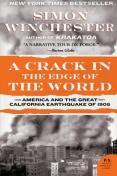
by Simon Winchester
Paperback- $10.98
Unleashed by ancient geologic forces, a magnitude 8.25 earthquake rocked San Francisco in the early hours of April 18, 1906. Less than a ...
Overall rating:
How would you rate this book?
Member ratings
Simon Winchester has elevated the language of science to the language of poetry. His eloquence will hold the attention of and also captivate the reader with his brilliant explanation of the formation of the earth, the ocean floor, the plates that shift and slide to wreak havoc or as he might say cause mischief in so many places. He describes such things as the molten lava “breathing” beneath our surface in such a way that you see the river of fire. He describes the movement of the faults so that you see them slipping and sliding under each other, layered irregularly atop each other, forming ridges like those in a carpet, as commonplace as a crease in a piece of fabric. He uses metaphors and similes to enlighten the reader and make the subject fluid rather than as arid as science can sometimes be for the layman.
When Winchester likens the movements of the plates to a freight train stuck on the tracks with only the center moving outward, the reader can surely see the force of that pressure as it moves the front of the cars forward, finally, in a burst, resulting in the return of that bulge to the center, although in the front there may be concomitant damage; and when he describes the ripple that erupts in a carpet, sometimes, after walking on it repeatedly, the reader will see that “pleat”, as he calls it, forming a mountain one day as it continues to rise. When he describes the splitting water mains and the rupturing gas lines, the reader can feel the disaster in San Francisco approaching, along with the heat, strong tremors and fear, as well as the astonishment and wonderment also felt by some victims. Winchester brought the dry science behind an earthquake and other natural disasters to life. I could visualize the earth forming, the continents moving and the oceans spreading as the earth moved beneath me. With a vocabulary that has become obsolete in the pens of most writers, as they concentrate on sound bites and acronyms, he has mastered the art of prose, making often unfathomable subject matter less bone-dry with his use of language.
Winchester speaks of Freud, Einstein, and Caruso in a casual manner as he creates the foundation for his story with vignettes that sometimes make the reader smile. He begins with the moon landing of Neil Armstong and tells the story of our magnificent planet. Viewing the earth from that bird’s eye view, he describes the inner core beneath the earth’s crust so well that you think you are listening to the secrets of a mystery novel that are slowly being fleshed out, when actually you are being presented with scientific facts. Traveling up and down the western coast of the United States, his explanations burst with information that are at once comprehensible rather than opaque. His research gleaned from journals, diaries and letters is impeccable and his knowledge coupled with his writing skill has made this a very enjoyable, informative read. I know that he placed me in San Francisco at the moment of the quake. I could almost feel the turmoil as the earth raged beneath its surface wreaking havoc above it.
Today, the technology has improved so much that analysis is done by machines more often then people, but the first hand accounts did not contain the coldness of the machine, and therefore the story was connected to emotion. I learned of the reputation San Francisco had when it was born, I could see the cavalier attitude that prevailed, the indifference to any impending disaster, although there had already been some in the previous century. He even draws a relationship between the rise of radical faiths like Islam and Pentacostal Evangelists during catastrophic times, equating the catastrophes to a sign of G-d’s displeasure and a need for doubling down on their dogma. His analysis of the behavior of the insurance companies during the disaster is still relevant today!
Although I cannot profess to have understood every word of this highly detailed and descriptive book, concentrating on the April, 17, 1906, San Francisco earthquake, I can say that I thoroughly enjoyed listening to this author read his own book with just the right tone and emotion to capture my ear completely. The book is both entertaining and informative.
Book Club HQ to over 90,000+ book clubs and ready to welcome yours.
Get free weekly updates on top club picks, book giveaways, author events and more








